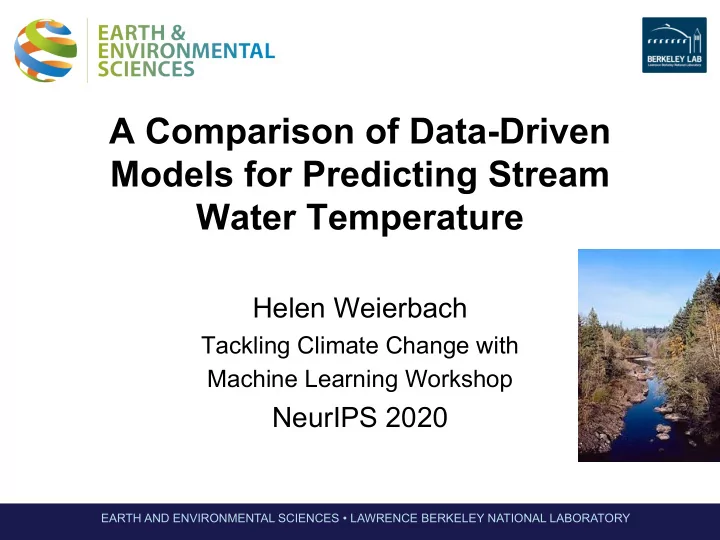

A Comparison of Data-Driven Models for Predicting Stream Water Temperature Helen Weierbach Tackling Climate Change with Machine Learning Workshop NeurIPS 2020 EARTH AND ENVIRONMENTAL SCIENCES • LAWRENCE BERKELEY NATIONAL LABORATORY
Research Objectives • To test the viability of low-complexity ML models and understand variables for predicting stream temperature at different spatial and temporal scales. • To predict impacts of extreme hydrological events (flood/drought) on stream temperatures Sandy River Watershed Council EARTH AND ENVIRONMENTAL SCIENCES • LAWRENCE BERKELEY NATIONAL LABORATORY
Relevance and Impact • Climate Change and Stream Water Temperature (WT) – WT drives stream physical and biogeochemical processes, important to aquatic life – Impacted by climate change: increased air temperature, disturbances, changing hydrological cycle – Water managers need local to regional WT predictions • Process models and Machine Learning (ML) for WT – SNTEMP Process Model, ML Models (LSTMs, MLPs outlined in Zhu et al. 2020) – Process-Guided Deep Learning hybrid models (USGS) – Test baseline approaches that can predict WT at different scales with broadly available measurements EARTH AND ENVIRONMENTAL SCIENCES • LAWRENCE BERKELEY NATIONAL LABORATORY
Methods- Monthly Predictions • Limited/ sparse available data * only 3 CAMELS with extremes stations have near complete 30 year – Input features: Meteorological WT records = station data from CAMELS Daymet selection – WT: data from USGS NWIS using BASIN-3D integration tool (Varadharajan et al. 2019) • ML Regression Models: – MLR, RF, SVR (persistence, historical) – 70/30 train-test split, random search cross validation hyperparameter optimization EARTH AND ENVIRONMENTAL SCIENCES • LAWRENCE BERKELEY NATIONAL LABORATORY
Preliminary Results EARTH AND ENVIRONMENTAL SCIENCES • LAWRENCE BERKELEY NATIONAL LABORATORY
Future Work • Expand spatial and temporal scales – More locations is US, test limits of meteorological data – Train models at daily frequency • Incorporate lags, exploratory data analysis, new input variables, increase model complexity – Sensitivity analysis, UQ • How do predictions change with different meteorological data sources, input features etc. Delaware River Basin Commission US Geological Survey EARTH AND ENVIRONMENTAL SCIENCES • LAWRENCE BERKELEY NATIONAL LABORATORY
Acknowledgements Contact: hweierbach@lbl.gov Co-authors: *CCAI mentor Charu Varadharajan Aranildo R. Lima* Boris Faybishenko Danielle Christianson Val Hendrix Funding EARTH AND ENVIRONMENTAL SCIENCES • LAWRENCE BERKELEY NATIONAL LABORATORY
Recommend
More recommend